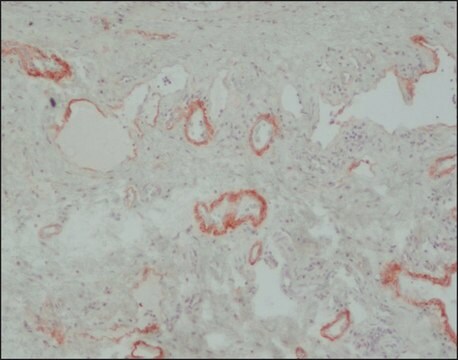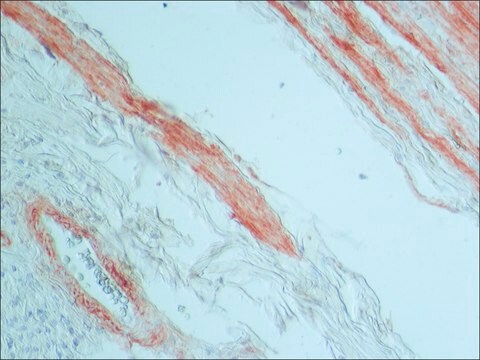T3413
Monoclonal Anti-Tenascin antibody produced in rat
clone MTn-12, ascites fluid
Synonym(e):
Anti-Tenascin-N
About This Item
Empfohlene Produkte
Biologische Quelle
rat
Qualitätsniveau
Konjugat
unconjugated
Antikörperform
ascites fluid
Antikörper-Produkttyp
primary antibodies
Klon
MTn-12, monoclonal
Enthält
15 mM sodium azide
Speziesreaktivität
mouse
Methode(n)
immunohistochemistry (frozen sections): suitable
immunoprecipitation (IP): suitable
indirect ELISA: suitable
indirect immunofluorescence: 1:200 using unfixed, frozen tissue sections of mouse intestine
western blot: suitable
Isotyp
IgG1
UniProt-Hinterlegungsnummer
Versandbedingung
dry ice
Lagertemp.
−20°C
Posttranslationale Modifikation Target
unmodified
Angaben zum Gen
mouse ... Tnn(329278)
Allgemeine Beschreibung
The tenascin molecule is a disulfide-linked hexamer; depending on species, the molecular weights of the subunits range from 190 to 320 kDa. In the mouse, two major subunits of tenascin with an apparent molecular weight of 210 and 260 kDa have been described. The shorter polypeptide predominates during earlier developmental stages and the larger polypeptide appears later in the embryonic gut and especially in the adult intestine. The expression of tenascin is associated with development and growth, both normal and pathological, whereas the distribution in normal adult tissue is restricted. It was proposed that actively growing, migrating and differentiating epithelial sheets can produce factors that can stimulate tenascin expression in the nearby mesenchyme. Human and chicken tenascin contain an RGD sequence which may function in cell adhesion and it seems likely that tenascin mediates cell attachment through an RGD dependent integrin receptor.
Spezifität
Immunogen
Anwendung
Immunohistochemistry (1 paper)
- Enzyme linked immunosorbent assay (ELISA)
- Dot blot.
- Immunoblotting
- Fluorescence microscopy and immunostaining
- Immunofluorescence
- Immunohistochemistry
Biochem./physiol. Wirkung
Haftungsausschluss
Not finding the right product?
Try our Produkt-Auswahlhilfe.
Lagerklassenschlüssel
10 - Combustible liquids
WGK
nwg
Flammpunkt (°F)
Not applicable
Flammpunkt (°C)
Not applicable
Analysenzertifikate (COA)
Suchen Sie nach Analysenzertifikate (COA), indem Sie die Lot-/Chargennummer des Produkts eingeben. Lot- und Chargennummern sind auf dem Produktetikett hinter den Wörtern ‘Lot’ oder ‘Batch’ (Lot oder Charge) zu finden.
Besitzen Sie dieses Produkt bereits?
In der Dokumentenbibliothek finden Sie die Dokumentation zu den Produkten, die Sie kürzlich erworben haben.
Unser Team von Wissenschaftlern verfügt über Erfahrung in allen Forschungsbereichen einschließlich Life Science, Materialwissenschaften, chemischer Synthese, Chromatographie, Analytik und vielen mehr..
Setzen Sie sich mit dem technischen Dienst in Verbindung.








